虎式坦克背后的无名英雄们......
原文:
DW (Durchbruchwagen) I
DW (Durchbruchwagen) II
Panzerkampfwagen VI
In late January of 1937, Waffenamt ordered Henschel und Sohn of Kassel to design and produce prototype of heavy 30-ton class tank. Designated as Durchbruchwagen I (Breakthrough Tank), it was to be Germany's first heavy tank intended to breakthrough enemy defense lines. Originally intended to replace either Panzer III or Panzer IV. Prototype of DW I was produced by Henschel and was protected by 50mm thick armor. The running gear consisted of five road-wheels and three return rollers (similar to PzKpfw III). Waffenamt put Krupp in charge of the production of the turret and its armament. Krupp decided to produce the turret similar to that of Panzer IV and armed with the same 75mm KwK 40 L/24 gun. Only one test hull was produced in late 1937, but its turret was never manufactured. At the time of the development of DW I, Waffenamt ordered Henschel to design and produce prototype of never heavy 30-ton class tank. Designated as DW II, it was an improved and modified version of previous DW I. Both, DW I (30000kg) and DW II (33000kg) were powered by Maybach HL 120 engine (280hp) allowing it to travel at the top speed of 35km/h. As well as DW I, only one prototype was built in 1938 and once again its turret was never manufactured. It was also planned to use PzKpfw IV Ausf C turret on DW II. In late 1938, DW project was cancelled and on September 9 of 1938, VK3001(H) project started. Both DW I and DW II were extensively tested until 1941 and provided Henschel with valuable experience used in the development of VK3001(H) tank and other future designs.
VK6501(H) / PzKpfw VII
In continuation with the development of the DW I/II and VK3001(H) tanks, on January 19th of 1939, Henschel was ordered to develop a heavy 65-ton class tank with similar layout to BW (Bataillonfuhrerwagen). Designated as Schwere Wagen (Sturmwagen) VK6501(H), it was intended to be a heavier version of Panzerkampfwagen IV. Krupp was put in charge of the turret development and production. Three different armament configurations were considered - 75mm KwK L/24, 75mm KwK L/40 and 105mm KwK L/20. In June of 1939, first configuration was accepted and in March of 1940, it was decided that the turret to be used was to be a modified turret used on DW (Durchbruchwagen) tanks. In April of 1940, wooden model was produced and Krupp was ordered to produce first trial turret.
Armament consisted of the turret mounted 75mm KwK 40 L/24 and 7.92mm MG34 (modified DW turret) and small turret mounted in the hull armed with 7.92mm MG34 (some sources state there were to be two small turrets). Prototype and early models were to be protected by 80mm thick armor, while production models were to be protected by 100mm thick armor. The running gear consisted of ten interleaved road-wheels and three return rollers with 800mm wide tracks. The maximum speed was to be between 20 and 25km/h. For transportation purposes, VK6501(H) could be taken apart into three main modules: forward module with driver's compartment and transmission, fighting compartment and the engine compartment. Also for transportation reasons, special heavy truck Faun L900D/567 (6x4) (equipped with two Demag LK 5S cranes) was developed but never produced along with flatbed trailers.
On September 1st of 1939, 0-Serie was ordered to be produced. Assembly was to be done by Henschel, while armor, turret and armament were to be provided by Krupp. In mid 1940, work on mild steel prototype began but entire project was halted in October of 1940. In mid 1941, turretless prototype was completed and delivered for testing at Sennelager proving grounds. VK6501(H) prototype was never completed with the turret and in late 1941, entire project was cancelled and scrapped in 1942, in favour of the development of VK3601(H). The main reason for cancellation was the fact that the vehicle due to its size and weight was considered to be tactically and logistically problematic in deployment and use.
Specifications
Weight: 65000kg
Crew: 5 men
Engine: Maybach HL 224 / 12-cylinder / 600hp
Speed: 20-25km/h
Lenght: 7.00m
Width: 3.20m
Height: 2.92m
Armament: 75mm KwK 37 L/24 & 2 x 7.92mm MG34
Armor: Front: 80mm (prototype)
Front: 100mm (production models)
VK3001(H) / PzKpfw VI (Ausf A)
VK3601(H) / PzKpfw VI (Ausf B)
VK3001(H) with concrete rings to simulate the weight of the turret.
On September 9 of 1938, Henschel received the permission to continue their work on new medium tank in continuation with DW development. Work on VK3001(H), which was further development of DW II, started. Two similar designs were created, lighter (32 tons) VK3001(H) and later on heavier (40 tons) VK3601(H). Both resembled Panzerkampfwagen IV in their hull design but their running gear was of a new design that consisted of overlapping road wheels. Medium VK3001(H) tank and heavy VK3601(H) tank had many common parts what would make their production and service much more easier.
Only four VK3001(H) prototypes were produced, two in March of 1941 and other two in October of 1941. All were completed in 1942 by Henschel. In the early 1942, one prototype VK3601(H) was build along with 5 prototype chassis. Originally, it was intended to mount VK3001(H) with a turret armed 75mm L/24 or 105mm L/28 gunm but none of the prototypes were actually fitted with turrets. VK3601(H) was to be armed with 75mm KwK 42 L/70 (Gerat 725), 88mm KwK 36 L/56 (mounted in VK4501(P) turret) or 105mm L/20 or L/28 gun, but just as VK3001(H), it was never armed with any weapons.
VK 3601(H) during tests.
Both designs were completed as prototypes but their further development was cancelled in 1942 in favour of the development of VK4501(H) - Tiger I. Turrets produced for both designs were never mounted and instead in 1944, 6 VK3001(H) turrets were used in permanent fortifications - Panzerstellung/Turmstellung of the Atlantic and West Wall. Their running gear which was later on modified and used a base for Tiger and Panther's running gear.
In March of 1941, two VK3001(H) were ready and from August of 1941 to March of 1942, were converted into 128mm Pak 40 L/61 gun carriers - Selbstfahrlafette 12.8cm. Other two prototypes that were completed in October of 1941, remained in Henschel's factory in Haustenbek and were used as recovery, training and test vehicles. VK3601(H) prototypes were used as recovery and towing vehicles.VK3001(H) and VK3601(H)'s design led to the subsequent development of Henschel's Tiger I.
Specifications
Model: VK3001(H)
Medium Tank VK3601(H)
Heavy Tank
Weight: 32000kg 40000kg
Crew: 5 men 5 men
Engine: Maybach HL 116 / 6-cylinder / 300hp Maybach HL 174 / 12-cylinder / 550hp
Speed: Road: 25-35km/h Road: 40km/h
Range: Road 150km
Lenght: 5.81m 6.05m
Width: 3.16m 3.14m
Height: 1.85m 2.70m
Armament: 75mm KwK 37 L/24
2 x 7.92mm MG34
105mm KwK L/28
2 x 7.92mm MG34 75mm KwK 42 L/70
2 x 7.92mm MG34
88mm KwK 36 L/56
2 x 7.92mm MG34
Armor (mm/angle): Front Turret: 50/
Front Superstructure: 50/10
Front Hull: 50/13.5
Side Turret: 30/
Side Superstructure: 30/0
Side Hull: 30/8
Rear Turret:
Rear Superstructure: 50/0
Rear Hull: 50/5.5
Turret Top / Bottom:
Superstructure Top / Bottom: 25/
Hull Top / Bottom: 20/90 / 35/20 & 22
Gun Mantlet: Front Turret: 100/10
Front Superstructure: 100/8
Front Hull: 100 & 60/23 & 60
Side Turret: 80/0
Side Superstructure: 60/0
Side Hull: 60/0
Rear Turret: 80/0
Rear Superstructure: 60/0
Rear Hull: 80/0
Turret Top / Bottom: 26/90
Superstructure Top / Bottom: 26/90
Hull Top / Bottom: 26/90
Gun Mantlet: 100/0
12.8cm Selbstfahrlafette L/61
(Panzerselbstfahrlafette V)
"Sturer Emil / Stubborn Emil"
Design of Selbstfahrlafette 12.8cm was based on Henschel's prototype of Panzer IV' successor - VK3001(H). In March of 1941, two VK3001(H) were ready to be converted into heavy anti-tank gun carriers - Panzerjagers. Rheinmetall-Borsig provided the 128mm PaK 40 L/61 gun for the main armament, which was developed in 1939, from 128mm Flak gun. Both chassis had to be modified in order to mount heavy 128mm gun. Major modifications consisted of the enlargement of the chassis (addition of one road-wheel, extension of the hull) and addition of the heavily armored open-top compartment mounted over the engine compartment. Fighting compartment was mounted in the rear of the vehicle and housed powerful 128mm anti-tank gun with limited traverse of 7 degrees to the left and to the right. Space inside the fighting compartment operated by the crew of five, allowed storage for only 15 to 18 rounds. One 7.92mm MG34 was mounted in the hull for local defence.
From August of 1941 to March of 1942, Rheinmetall-Borsig and Henschel produced two prototypes, which were troop tested in Russia in mid 1942. Both prototypes performed successfully but the development of this project was cancelled in favour of Tiger I. One of Selbstfahrlafette 12.8cm (pictured above) saw service with 521st schwere Panzerjaeger Abteilung and second one with 2nd Panzer Division as late as July of 1942. One of two prototypes (from 2nd Panzer Division) was destroyed in combat, while other one (from 521st sPzJagAbt with 22 kills rings painted on the gun barrel) was captured intact in January of 1943 in Stalingrad area. It was shown at the captured equipment exhibitions in Moscow's Gorky Park in 1943 and 1944. Vehicles were named "Max" and "Moritz" after characters in Busch's classic children's story. Today, the one captured by the Red Army can be seen in the Museum of Armored Forces in Kubinka (Russia).
Specifications
Weight: 35000kg
Crew: 5 men
Engine: Maybach HL 116 / 6-cylinder / 300hp
Speed: 23-25km/h
Lenght: 9.70m
Width: 3.16m
Height: 2.70m
Armament: 128mm PaK 40 L/61 & 7.92mm MG34
Ammo: 128mm - 15-18 rounds
7.92mm - 600 rounds
Armor (mm/angle): Front Hull: 50/13.5
Front Superstructure: 50/8
Front Turret: 50/14.5
Gun Mantlet: 50/40
Side Hull: 30/0
Side Superstructure: 30/0
Side Turret: 15/10
Rear Hull: 30/45
Rear Superstructure: 15/16
Rear Turret: 15/14.5
Hull Top / Bottom: 20/90 / 35/20 & 22
Superstructure Top / Bottom: 15/90
Turret Top: open
Penetration of Armor Plate at 30 degrees from Vertical.
Ammunition: 100m 500m 1000m 1500m 2000m
Panzergranate 39 201mm 176mm 150mm 132mm 120mm
Pzgr.39 (APCBC) - Armor Piercing Composite Ballistic Cap
VK3001(P) Leopard
Porsche Type 100
In 1937, along with Henschel, Porsche was given the task of build the medium tank that would replace Panzerkampfwagen IV. Its design was supposed to be capable of being armed with 75mm L/24 or even if possible 105mm L/28 gun and one 7.92mm MG34 for local defence. VK3001(P) was Porsche's first design since 1927's Grosstraktor I and its drawings were finished by September 5th of 1939 by Porsche's Chief Engineer Karl Rabe.
Prototypes were supposed to be fitted with turrets manufactured by Krupp. Porsche considered arming the vehicle with 105mm KwK L/47, 105mm KwK L/52 gun and finally with 88mm KwK 36 L/56 gun (developed from 88mm Flak 36 gun). Six turrets armed with 88mm guns were ordered in April of 1941, but none were produced. Leopard's turret was similar in appearance to that used on Tiger(P) and Tiger. Porsche planned to power VK3001(P) with gasoline-electric power/drive system (two air-cooled Porsche Typ 100 engines by Steyr and electric transmission). Only one or two turretless prototypes were completed by Nibelungenwerke in St.Valentin, Austria in late (October) 1941, out of 3 hulls originally ordered. Although many problems were encountered with its advanced power and drive system, prototype(s) performed well. During tests prototype(s) reached maximum speed of 60km/h but its fuel consumption was 170 liters per 100 kilometers. In order to solve the engine problems, Porsche designed diesel engine (Porsche Typ 200) but it was never produced.
VK3001(P) program was abandoned and two prototypes were used extensively in the development of VK4501(P) - Porsche's Tiger, which started in July of 1941. In order to transport VK3001(P) tank, Porsche designed special tank transporter (Panzertransporter Porsche 142), but this project was also abandoned. Tests continued until May of 1942, but VK3001(P) never went into production just like VK3001(H) and VK3601(H).
Specifications
Weight: 30000kg
Crew: 5 men
Engine: 2 x Porsche Typ 100 / 10-cylinder / 210hp
Speed: 60km/h
Lenght: 6.58m
Width: 3.80m
Height: 3.05m
Armament: 75mm KwK 37 L/24 & 7.92mm MG34
105mm KwK L/28 & 7.92mm MG34
Armor (mm/angle): Front Turret: 80/21.5
Front Superstructure: 75/15
Front Hull: 75/20 & 45
Side Turret: 60/0
Side Superstructure: 60/0
Side Hull: 60/0
Rear Turret: 60/0
Rear Superstructure:
Rear Hull: 40/31.5 & 0
Turret Top / Bottom: 40/10 & 15
Superstructure Top / Bottom: 26/90
Hull Top / Bottom: 26/90
Gun Mantlet: 80/0
未能实现的“突破”战车:DW(Durchbruchwagen)I / II
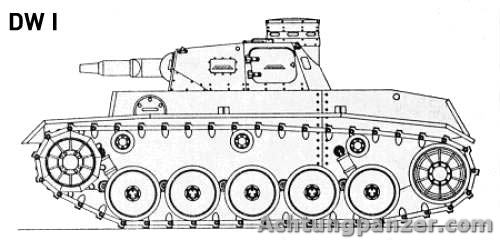
在1937年一月下旬,装备部 命令了卡塞尔的亨舍尔设计而且生产30吨级坦克的原型车。 起名为“突破战车”(Durchbruchwagen),它将成为德国的第一种用来突破敌人防线的坦克,本来想要它来替代三号坦克或者四号坦克中的一种。DW I由亨舍尔制造,有50mm装甲保护。 行走装置由5个负重轮和3个托带轮(类似于PzKpfw 3)所组成。装备部命令克虏伯负责制造炮塔和武器。克虏伯决定生产与四号坦克类似的炮塔而且采用相同的 75mm KwK 40 L/24火炮。 只有一辆测试车体于1937年被生产出来,但是它的炮塔从未制造。 在DW I发展期间,装备部命令亨舍尔设计而且生产另一个30吨级坦克的原型车, 命名为DW II。 它是先前DW I的改良版。DW I(30000kg)和 DW 2(33000kg) 都采用梅巴赫HL 120 引擎 (280hp), 能够让它们以最高35km/h的速度行动。和DW I一样,一辆原型在1938年被建造,而且也没有制造它的炮塔。计划中DW II将使用 PzKpfw 4 Ausf C的炮塔。在1938年晚期,DW计划被取消。同年九月9日VK3001(H) 计划开始。DW I和 DW II都参加了大量的测试直到1941年,而且为亨舍尔的VK3001(H)坦克以及未来的“虎”式的发展提供了宝贵的经验。
VK6501(H)/ PzKpfw 7
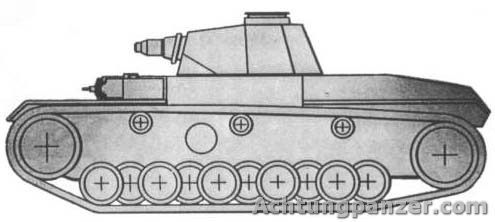
为了继续DW I/II和 VK3001(H)坦克的发展,在1939年一月19日,亨舍尔接到命令生产一种外形和BW.(Bataillonfuhrerwagen,排长指挥车,即日后的三号坦克)类似的65吨级坦克,命名为VK6501(H)突击战车(Sturmwagen), 它被计划成一个重型版的四号坦克,克虏伯负责炮塔的开发和制造。考虑过三个不同的武器方案------ 75mm KwK L/24、75mm KwK L/40 和 105mm KwK L/20。在1939年六月,第一方案被接受并且在1940年三月,炮塔被确定为DW坦克炮塔的改良版。在1940年四月木制模型被生产,而且克虏伯接到命令生产第一个实验炮塔。
炮塔上的武器包括75mm KwK 40 L/24火炮和7.92mm MG34机枪(改进DW 炮塔)和在安装在车体上的一个(一些资料认为有两个)装有7.92mm MG34机枪的小炮塔。 原型和早期型被 80mm厚的装甲保护,而生产型由100mm厚的装甲保护。行走装置由十个交错负重轮和三个托带轮以及800mm履带所组成。最大的速度20 ~25km/h。出于运输目的,VK6501(H)可以拆成三部分: 前隔间,包括驾驶室和传动装置;作战隔间和引擎隔间。也出于运输目的,特别的“农牧神”( Faun L900D/567)6x4重型卡车 (装备二台德玛格LK 5S起重机)被开发出来,但是除了平板拖车以外没有生产出来。
在1939年九月一日,0-系列开始生产。克虏伯提供装甲、武器和炮塔,亨舍尔进行组装。 在 1940年中期软金属模型的制造开始但是在同年十月整个计划停止。在1941年中期,无炮塔的原型车被制造出来并且运输到瑟内拉格(Sennelager)试验场进行测试。VK6501(H) 原型车永远没有完工,在1942年计划被放弃,转向VK3601(H) 的发展。取消的主要理由是因为这种车辆的尺寸和重量在战术使用和后勤保障上存在太大的困难。
规格
重量:65000kg
乘员::5人
引擎:梅巴赫HL 224/12缸/600hp
速度:20-25 km/h
长度:7.00m
宽度:3.20m
高度:2.92m
军备:75mm KwK 37 L/24&2 x 7.92mm MG34
装甲:前面: 80mm(原型)
前面: 100mm(生产型)
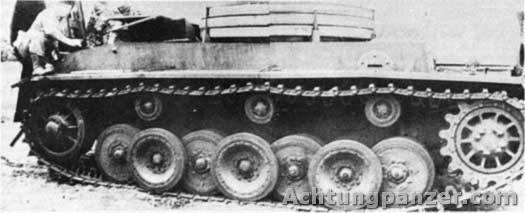
装有模拟炮塔重量的水泥圆环的VK3001(H)。
在1938年九月9日,亨舍尔受到许可在DW的发展基础上继续开发新的中型坦克。VK3001(H)--- DW2的改进型的开发工作开始了。二个类似的设计被提出,轻型的 (32 吨) VK3001(H)和后来的比较重的(40 吨)VK3601.(H)。两者的车体设计都接近 Panzerkampfwagen 4 但是他们的行动装置是由新设计的交叉路轮所组成的。中型VK3001(H)坦克和重型 VK3601(H)坦克有很多相同的共用部分,这样可以简化它们的生产。
只有四辆VK3001(H) 原型车被生产, 二辆在1941年三月,另外的在1941年10月。亨舍尔1942年完成了全部生产。1942年早期,一辆VK3601(H)原型车连同 5 原型底盘一起被生产出来。 本来准备为VK3001(H)安装装有75mm L/24 或 105mm L/28火炮的炮塔,但是实际上没有一辆原型车安装炮塔。 VK3601(H)计划安装75mm KwK 42 L/70(Gerat 725)、88mm KwK 36 L/56(虎(P)炮塔) 或 105mm L/20 或 L/28 火炮,但是和VK3001(H)一样,它从来没安装任何武器。
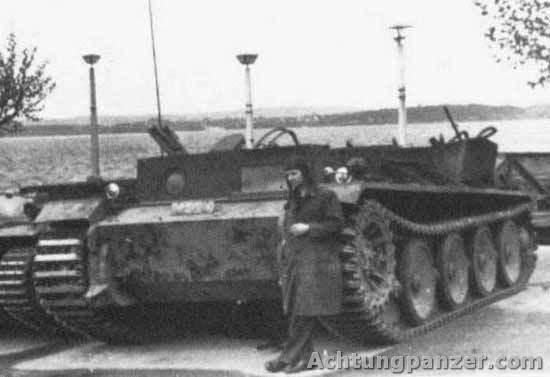

在测试期间的 VK 3601(H)
两种设计的原型车都已经完成,但是为支持VK4501 (H)-- -虎I的发展,进一步的发展在1942年被取消。为两者设计的炮塔没有再启用,并且在1944年6个 VK3001(H)的炮塔在大西洋壁垒和西墙防线的永备防御工事中被当做装甲炮塔(Panzerstellung/ Turmstellung)使用。 它们的行走装置在后来改造后被“虎”式及“豹”式坦克使用。
在1941年三月,两辆VK3001(H) 准备完毕。从1941年八月起到1942年三月,它们被改装成 128mm Pak 40 L/61反坦克炮运输车---Selbstfahrlafette 12.8cm。 另外二辆原型车在1941年十月被完成, 一直保留在亨舍尔在豪斯滕贝克(Haustenbek)的工厂中而且被当作维修、训练和测试车辆使用。VK3601(H) 原型被用来当维修车和拖车来使用.的后来“虎”式坦克的设计就是VK3001(H) 和 VK3601(H)的进一步发展。
规格
型号 VK3001(H)中型坦克 VK3601(H)重型坦克
重量 32000kg 40000kg
乘员 5 5
引擎 梅巴赫HL 116 / 6缸 / 300hp 梅巴赫HL 174 / 12缸 / 550hp
速度 道路: 25-35km/h 道路: 40km/h
行程 道路150km
长度 5.81m 6.05m
宽度 3.16m 3.14m
高度 1.85m 2.70m
武器 75mm KwK 37 L/24
2 x 7.92mm MG34
105mm KwK L/28
2 x 7.92mm MG34 75mm KwK 42 L/70
2 x 7.92mm MG34
88mm KwK 36 L/56
2 x 7.92mm MG34
装甲(mm/角度): 炮塔前部: 50/
上层结构前部: 50/10
车体前部: 50/13.5
炮塔侧面: 30/
上层结构侧面 30/0
车体侧面: 30/8
炮塔后面:
上层结构后面: 50/0
车体后面: 50/5.5
炮塔顶部 / 底部:
上层结构顶部 / 底部: 25/
车体顶部/底部: 20/90 / 35/20 & 22
火炮防盾: 炮塔前部: 100/10
上层结构前部: 100/8
车体前部: 100 & 60/23 & 60
炮塔侧面: 80/0
上层结构侧面: 60/0
车体侧面: 60/0
炮塔后面: 80/0
上层结构后面: 60/0
车体后面: 80/0
炮塔顶部 / 底部: 26/90
上层结构顶部 / 底部: 26/90
车体顶部/底部: 26/90
火炮防盾:100/0
12.8cm Selbstfahrlafette L/61
(Panzerselbstfahrlafette V)
"Sturer Emil / Stubborn Emil"
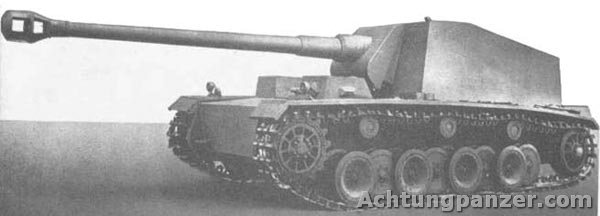
Selbstfahrlafette 12.8cm 的设计以亨舍尔的4号坦克继承者--- VK3001.(H)原型车为基础。在1941年三月, 二辆VK3001(H) 准备被转换成重型反坦克炮运载车---坦克猎手。 莱茵金属-博尔希格提供的128mm PaK 40 L/61炮作为主要武器, 这种火炮源自 128mm 高射炮,开发工作始于1939 年。 两辆底盘都被改装过以承载128mm重型火炮。主要的修改包括扩大底盘(增加一个负重轮并且加长了车体)和在引擎室上方增加重装甲敞开式隔间。 作战隔间在车体后部,安装有强大的128mm反坦克炮,左右摇摆7度。作战舱里有5名乘员,仅携带15~18发炮弹。一挺防御用的7.92mm MG34机枪安装在车体上。
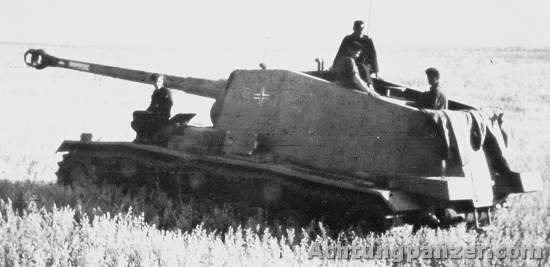
从1941年八月到1942年三月,莱茵钢铁-博尔希格和亨舍尔生产了二辆原型车, 1942 中期在俄国进行战地测试.两辆原型车的表现十分出色,但是为了给“虎”式坦克的发展让路这个计划被取消。 上图的Selbstfahrlafette 12.8cm在521装甲猎手营服役,另外一辆(至1942年7月)在第二装甲师服役。 两辆原型车之一(第二装甲师那辆)在战斗中被摧毁, 而另一辆 (在炮管上绘有22个击毁环)于1943年一月在斯大林格勒地区被缴获。 1943~1944年间它在莫斯科的高尔基公园中与其他缴获装备一起被展览。 两辆车根据布施(Busch)的童话故事被命名为马克斯(Max)和莫尼茨(Moritz)。 今天,被红军缴获的那辆能在俄罗斯的库宾卡坦克博物馆被发现。
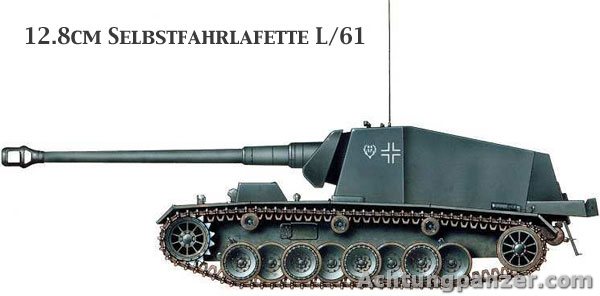
规格
重量:35000kg
乘员:5人
引擎:梅巴赫HL 116/6缸/300hp
速度:23-25 km/h
长度:9.70m
宽度:3.16m
高度:2.70m
武器:128mm PaK 40 L/61&7.92mm MG34
弹药:128mm- 15-18发
7.92mm- 600发
装甲 公厘/角) 公厘/角)
炮塔前部: 50/13.5
上层结构前部: 50/8
车体前部: 50/14.5
炮塔侧面: 15/10
上层结构侧面30/0
车体侧面: 30/0
炮塔后面: 15/14.5
上层结构后面: 15/16
车体后面: 30/45
炮塔顶部 / 底部: 敞开
上层结构顶部 / 底部: 15/90
车体顶部/底部: 20/90/35/20&22
火炮防盾: 50/40
对30度钢板的射击效果
Ammunition: 100m 500m 1000m 1500m 2000m
Panzergranate 39 201mm 176mm 150mm 132mm 120mm
Pzgr.39 (APCBC) -被帽穿甲弹
Selbstfahrlafette 12.8cm图籍
在苏联南部草原上的Selbstfahrlafette 12.8cm

----------------------------------------------------------------
被缴获的Selbstfahrlafette 12.8cm

展览中......

战斗隔间内部

出厂时的档案照

1942年7月被击毁的那辆Selbstfahrlafette 12.8cm

-----------------------------------------------------------------
1943年一月发现的被遗弃的Selbstfahrlafette 12.8cm



----------------------------------------------------------------
一位乘员正在炮管上画击毁环

VK3001(P) Leopard
Porsche Type 100
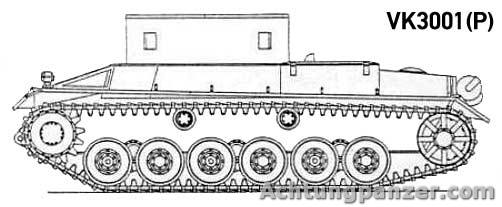
在 1937 年保时捷同亨舍尔一起接到生产替换4号坦克的战车的命令。计划中这种坦克将使用75mm L/24火炮,甚至有能力使用105mm L/28火炮,一挺7.92mm MG34机枪作为固定防御。VK3001( P) 是保时捷自从1927年的Grosstraktor 以来设计的第一辆坦克。它的设计图在1939年九月5日之前被保时捷的总工程师卡尔.卢比(Karl Rabe)完成。
原型车配备有克虏伯制造的炮塔。保时捷考虑过安装105mm KwK L/47或者105mm KwK L/52 火炮。最后采用 88mm KwK 36 L/56 火炮(从 88mmFlak-36发展过来)。1941年4月下了6个安装88mm炮的订单但是没有一个被生产出来。 “利奥波德”的炮塔看上去和虎 (P)以及“虎”式上用的类似。 保时捷计划使用汽油-电力系统(二台斯泰尔生产的气冷保时捷Typ 100引擎和电力传动装置)作为VK3001(P)的动力装置。 总共预订了3辆原型车,只有一到二辆无炮塔的原型车于1941年晚期(十月)在奥地利圣瓦伦丁的尼伯龙根工厂完成。 虽然它的超前的动力和传动装置具有许多问题,但是原型车的表现很好。在测试期间设计原型车达到了60km/h 的最大速度,但是它的燃料消耗比是百公里170升。为了要解决引擎问题,保时捷设计了柴油引擎版(Porsche Typ 200), 但是从未被生产。
VK3001(P)的计划被放弃,二个原型底盘在自1941年7月开始的“虎”P的开发过程中被广泛的运用。为了运输VK3001(P),保时捷设计了特别的坦克运输车(Panzertransporter Porsche 142),但是这个计划也被放弃。尽管测试持续到1942年五月,但是 VK3001(P)和VK3001(H) 和 VK3601(H)的命运一样---从来没有进入生产。
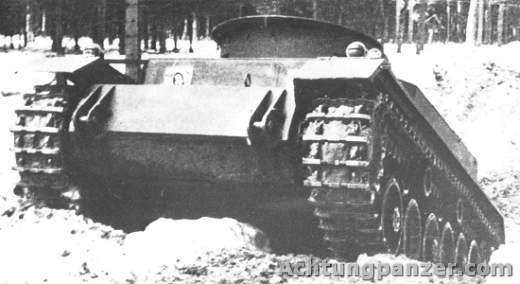
规格
重量:30000kg
乘员:5人
引擎:2 x保时捷Typ 100/10缸/210hp
速度:60km/h
长度:6.58m
宽度:3.80m
高度:3.05m
武器:75mm KwK 37 L/24&7.92mm MG34
105mm KwK L/28&7.92mm MG34
装甲 公厘/角) 公厘/角)
炮塔前部: 80/21.5
上层结构前部: 75/15
车体前部: 75/20&45
炮塔侧面: 60/0
上层结构侧面:60/0
车体侧面: 60/0
炮塔后面: 60/0
上层结构后面:
车体后面: 40/31.5&0
炮塔顶部 / 底部: 40/10&15
上层结构顶部 / 底部: 26/90
车体顶部/底部: 26/90
火炮防盾: 80/0 |